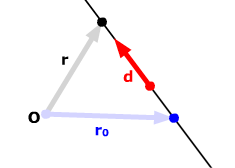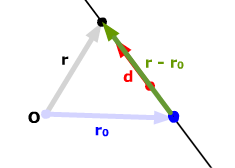Notice that parallel lines have parallel direction vectors.
• a single point on the line (called the initial point)
• a vector giving the direction of the line (called a direction vector)
Look at the vector r - r0. It's parallel to the direction vector, and so must be a scalar multiple of it:
r - r0 = td
for some scalar t. Solve for r:
r = r0 + td .

Now let's see if we can derive an equation for a line. Label the direction vector d. Let r be the position vector for a generic point on the line, and let r0 be the position vector for the initial point.

- If a line passes through the origin of the coordinate system, you could choose its initial point to be r0 = 0. The vector equation of the line would then have form r = td, i.e. the position vectors of all points on the line are multiples of the direction vector. (This would not be true if you chose some other initial point on the line.)
- If a line is parallel to the x-axis, you could choose a direction vector d = i, so the line would have equation r = r0 + ti. Similarly, a line parallel to the y-axis could have direction vector j and one parallel to the z-axis, a direction vector k.
- The direction vector of a line parallel to the x-y-plane cannot have a z-component.
The direction vector then must be of the form ai +
bj,
so such lines have vector equation
r = r0 + t(ai + bj).
 Using
Vectors to Describe Lines Using
Vectors to Describe Lines |
|||||
| Introduction | The vector form of a line | The parametric form of a line | The symmetric form of a line | Finding lines | Uniform linear motion |
It's also important to notice that the initial point and direction vector of a line are not unique:
- the initial point can be any point on the line
- the direction vector can be any non-zero vector that points in the appropriate direction.
If you chose a different direction vector or a different initial point for this line, you would get different values of t for each generic point on the line: the parameter t is tied to your choice of a particular initial point and direction vector.